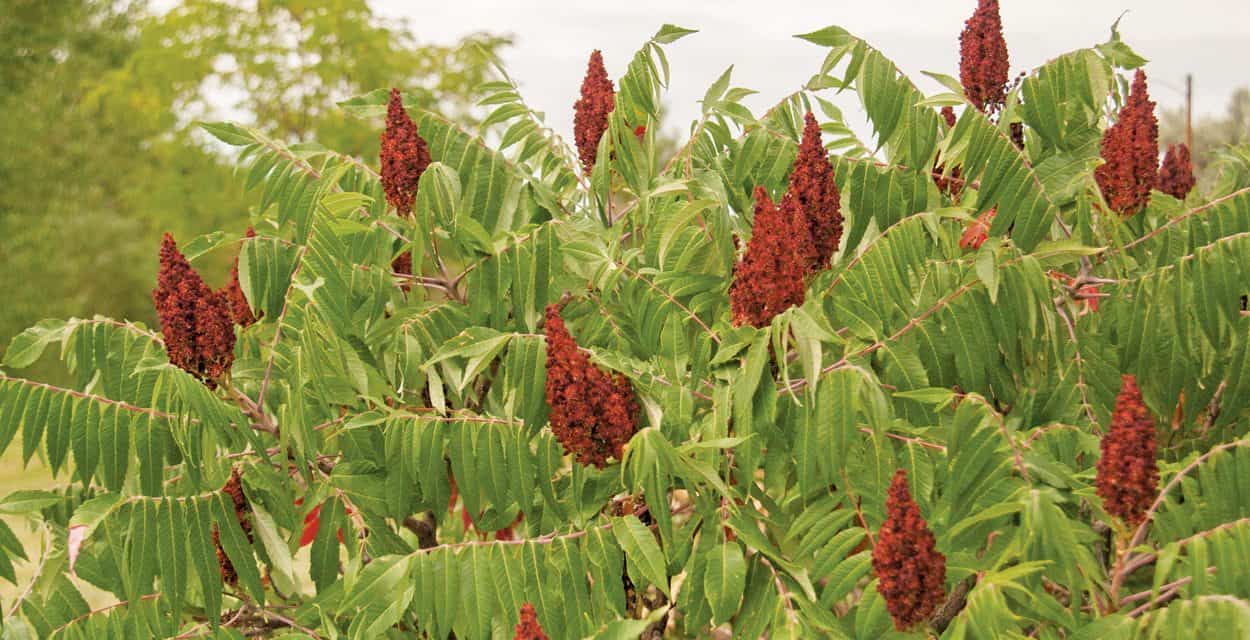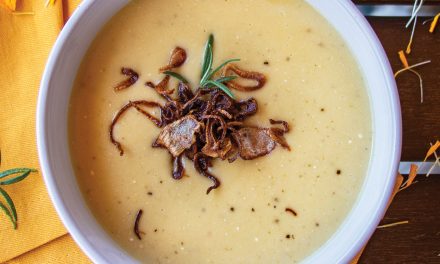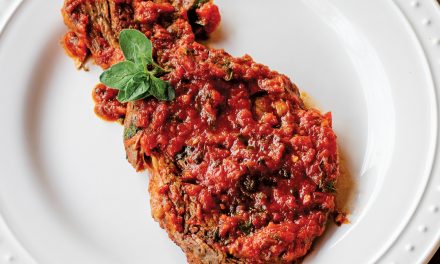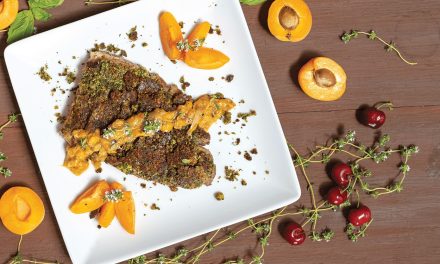Words and Photos by Ellen Zachos
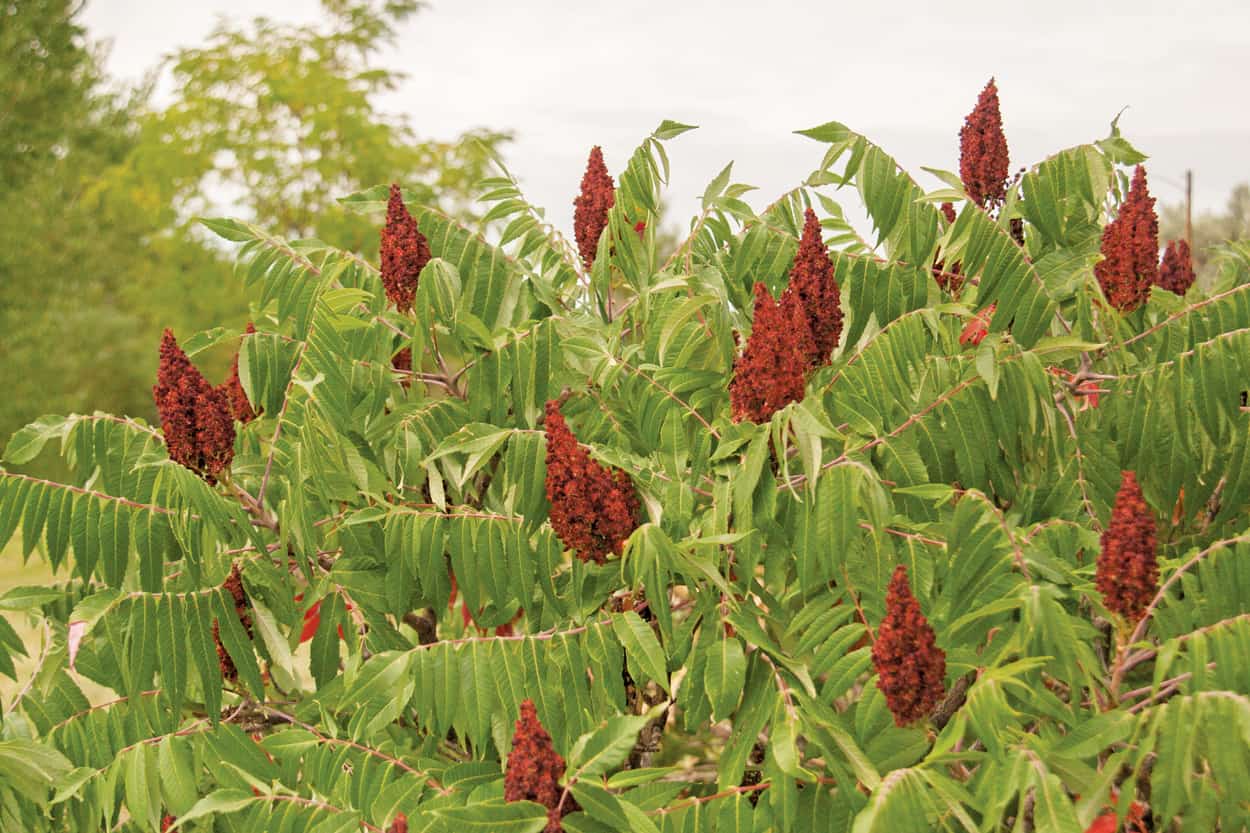
R. glabra (a.k.a. smooth sumac) is native to about half of New Mexico’s counties.
New Mexico has several native species of edible sumac. Rhus trilobata (a.k.a three-leaf sumac) is native to most of the state and is a popular landscape plant, valued even more for its exceptional red fall foliage than for its tasty fruit. R. glabra (a.k.a. smooth sumac) is native to about half of New Mexico’s counties, and is also found as a feral and cultivated shrub throughout the state. R. lanceolata (a.k.a. prairie sumac) is native to Doña Ana and Eddy Counties, and the rare R. virens (a.k.a. evergreen sumac), is native to a few southern counties. All of these species produce edible, tart fruit.
Depending on the species and where you’re foraging, berries will ripen from June through September. Sumac fruit looks ripe long before its flavor is fully developed, so it’s important to taste the fruit periodically. You’ll know it’s ready to be harvested when a berry has a strong, lemony flavor. That flavor comes from a coating of malic acid (also found in apples, grapes, and plums). Timing is everything when it comes to harvesting sumac, because the acid is washed away by rain, so gather your sumac as soon as possible after the berries ripen. That can be tricky in New Mexico; in some parts of the state, sumac ripens smack dab in the middle of monsoon season.
Sumac berries are appreciated around the world for their tart flavor. In the Middle East, they’re used in za’atar, a spice mix that brightens up savory dishes. Closer to home, the traditional Diné dish chilchin is a pudding made with dried, ground sumac fruit.
I won’t lie to you—making your own ground sumac spice takes some time, but it’s not difficult and it’s definitely worthwhile. While you can buy R. coriaria (the European/Asian species) in stores, the flavors of our local sumacs are more intense, and the spice itself has a lighter, brighter color.
Once you’ve harvested your fruit, dry the clusters to preserve them. Use a dehydrator at 95 degrees Fahrenheit, or place the berries in a paper bag and hang it somewhere dark and dry for two to four weeks and let dry. After that, store them in a large glass jar for up to a year.
Here’s how to make your own sumac spice: Remove the dried berries from their stems and put them in a blender or spice grinder. Give them a few pulses. You’re not trying to pulverize the dried fruit; you just want to separate it from the large seeds, which can have a bitter flavor. Transfer the broken-up berries to a metal strainer and rub the fruit through the mesh with your fingers, leaving the seeds behind. Yes, it’s a little tedious, but you’ll be glad you did it when you’re enjoying that bright, tart flavor in the middle of winter. Add your sumac to dry rubs, pasta dishes, or salad dressings, or try this recipe for steamed sumac buns.

Steamed Sumac Buns
Ingredients
- 3/4 cup pancake mix
- 2 tablespoons dried ground sumac
- 1 egg beaten
- 1 tablespoon vegetable oil
- 3 tablespoons milk
- 3 tablespoons sugar
Instructions
- Combine the egg, vegetable oil, milk, and sugar in a bowl. Add the pancake mix and sumac; stir to combine.
- Grease the muffin tin, and distribute the batter evenly among the cups. Place the tin in a large pan, and add enough water to come within a half-inch of the top of the tin. Cover, and turn the burner on to medium-high heat.
- Steam the buns for 12–15 minutes (from the time you turn on the burner), until they are round and puffy. The buns are ready when you can feel them bounce back from (but not stick to) the gentle push of your fingertip.
- Steamed sumac buns are best served warm. Leftovers can be reheated in a steamer or microwave.

Sumac-ade
Special Note:
Does the word “sumac” make you nervous? Does it conjure up images of itchy, red rashes? Are you worried that it’s poison? Fear not! Poison sumac (Toxicodendron vernix) is a completely different plant, and according to the USDA, poison sumac has never been reported in New Mexico. Why? Because poison sumac grows primarily in the eastern United States in wet, swampy soils. Even there, it’s a rare plant.
And here’s the most important thing: ripe poison sumac fruit is white, borne in clusters that emerge from leaf axils along the stem. Ripe, edible sumac fruit (Rhus spp.) is red, and produced in terminal clusters, only at the ends of branches. It’s easy to tell the difference between poison sumac fruit and edible sumac fruit at harvest time. If it’s red, go ahead. If it’s white, run in fright. (Okay, you don’t really have to run; just don’t touch it.)
When trying any new food, whether it’s foraged or store bought, try a small amount first, especially if you have food allergies. Sumac is in the plant family Anacardiaceae, which also includes mangoes and cashews. If you’re allergic to either of those foods, start slowly with sumac.
Edible celebrates New Mexico's food culture, season by season. We believe that knowing where our food comes from is a powerful thing. With our high-quality, aesthetically pleasing and informative publication, we inspire readers to support and celebrate the growers, producers, chefs, beverage and food artisans, and other food professionals in our community.

